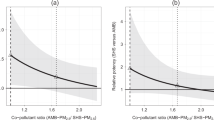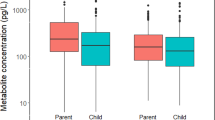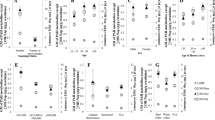Abstract
In the context of a large-scale molecular epidemiology study of biomarkers of genotoxicity of air pollution, 24-h mean personal exposures to airborne PM 2.5 (particulate matter <2.5 μm) and associated polycyclic aromatic hydrocarbon (PAHs) were measured in 194 non-smoking technical institute students living in the city of Athens, Greece (an area with moderately high levels of air pollution) and the nearby small town of Halkida anticipated to have lower pollution levels. Extensive information relevant to the assessment of long-term and recent exposure to PAH was obtained from questionnaires as well as a time–location–activity diary (TLAD) which was kept by all subjects during a 4-day observation period. During the last 24 h of this period, subjects underwent personal exposure monitoring for PM 2.5 and PAH, while a sample of blood was donated at the end of this period. All subjects were monitored in this way twice; once during a winter season (October–February) and once during the following summer season (June–September). Nine subjects with plasma cotinine levels above 20 ng/ml were considered as unreported smokers and excluded from the study. Winter PM 2.5 exposures were lower in Athens (geometric mean 39.7 μg/m 3) than Halkida (geometric mean 56.2 μg/m 3) ( P<0.001), while there was no significant location difference during the summer (Athens: geometric mean 32.3 μg/m 3, Halkida: geometric mean 32.9 μg/m 3; P=0.79). On the other hand, PAH exposures (sum of the eight carcinogenic PAHs) were significantly higher in Athens than in Halkida during the winter (Athens: geometric mean 8.26 ng/m 3, Halkida: geometric mean 5.80 ng/m 3; P<0.001) as well as during the summer (Athens: geometric mean 4.44 ng/m 3, Halkida: geometric mean 1.48 ng/m 3; P<0.001). There was a significant difference in the profile of the PAH exposures at the two locations, the proportion of lighter PAH (benzo[ a]anthracene, chrysene [CHRYS], benzo[ k]fluoranthene, and benzo[ b]fluoranthene) being higher, and that of heavier PAH (benzo[ ghi]perylene [BPer] and indeno[1,2,3, cd]pyrene) lower, in Halkida than in Athens, regardless of season. This difference appeared to be related to individual exposure to environmental tobacco smoke (ETS), as indicated by (a) the correlation at the individual level between the CHRYS/BPer ratio and declared time of recent exposure to ETS as well as plasma cotinine levels, especially during the winter; (b) the parallel variation of the mean levels of all three markers (declared ETS exposure, cotinine levels, CHRYS/BPer ratio) among three subgroups of subjects (Athens subjects who had lowest levels of all three markers; Halkida subjects other than those living in the institute campus area; and Halkida subjects living in the institute campus area who had the highest levels of all three markers). This demonstrates that ETS can have a distinctive effect on the PAH exposure profile of subjects exposed to relatively low levels of urban air pollution.
This is a preview of subscription content, access via your institution
Access options
Subscribe to this journal
Receive 6 print issues and online access
$259.00 per year
only $43.17 per issue
Buy this article
- Purchase on Springer Link
- Instant access to full article PDF
Prices may be subject to local taxes which are calculated during checkout







Similar content being viewed by others
Abbreviations
- PAH:
-
polycyclic aromatic hydrocarbon
- PM 2.5:
-
particulate matter < 2.5 μm
- ETS:
-
environmental tobacco smoke
- B[ a]A:
-
benzo[ a]anthracene
- CHRYS:
-
chrysene
- B[ b]F:
-
benzo[ b]fluoranthene
- B[ k]F:
-
benzo[ k]fluoranthene
- B[ a]P:
-
benzo[ a]pyrene
- DBA:
-
benzo[ a, h]anthracene
- BPer:
-
benzo[ ghi]perylene
- IND:
-
indeno[1,2,3, cd]pyrene
- TLAD:
-
time–location–activity diary
- TEI:
-
Technical Educational Institute.
References
Anwar WA and Kamal AAM, Cytogenetic effect in a group of traffic policemen in Cairo. Mutat. Res. (1988) 208: 225–231
Back SO Field RA Goldstone ME Kirk PW Lester JN and Perry R, A review of atmospheric polycyclic aromatic hydrocarbons: sources, fate and behavior. Water, Air, Soil, Pollut. (1991) 60: 273–300
Benowitz NL, Biomarkers of environmental tobacco smoke exposure. Environ. Health Perspect. (1999) 107(suppl 2): 349–355
Binkova B, Lewtas J, Miskova I, Lenicek J, and Sram R, DNA adducts and personal air monitoring of carcinogenic polycyclic aromatic hydrocarbons in an environmentally exposed population. Carcinogenesis (1995) 16: 1037–1046
Binkova B, Lewtas J, Miskova I, Rossner P, Cerna M, Peterkova K, Mrackova G, Mumford J, Meyer S, and Sram R, Biomarker studies in Northern Bohemia. Environ. Health Perspect. (1996) 104(suppl 3): 591–597
Binkova B Topinka J Mrackova G Gajdosova D Vidova P Stavkova Z Peterka V Pilcik T Rimar V Dobias L Farmer PB and Sram RJ, Coke oven workers study: the effect of exposure and GSTM1 and NAT2 genotypes on DNA adduct levels in white blood cells and lymphocytes as determined by 32P postlabelling. Mutat. Res. (1998) 416: 67–84
Bjorseth A, and Lunde G, Long-range transport of polycyclic aromatic hydrocarbons. Atmos. Environ. (1979) 13: 45–53
Bodzek D, Luks-Betlej K, and Warzecha L, Determination of particle associate polycyclic aromatic hydrocarbons in ambient air samples from the Upper Silesia region of Poland. Atmos. Environ. (1993) 27A: 759–764
Brown JR Field RA Goldstone ME Lester JN and Perry R, Polycyclic aromatic hydrocarbons in central London air during 1991 and 1992. Sci. Total Environ. (1996) 177: 73–84
Chandrasekaran R Samy PLP and Murphy PBK, Increased sister chromatid exchange (SCE) frequencies in lymphocytes from traffic policemen exposed to automobile exhaust pollution. Hum. Exp. Toxicol. (1996) 15: 301–304
Chuang JC Mack GA Kuhlman MR and Wilson NK, Polycyclic aromatic hydrocarbons and their derivatives in indoor and outdoor air in an eight-home study. Atmos. Environ. (1991) 25B: 369–380
Colomsjo AL Zebuhr YU and Ostman CE, Polycyclic aromatic compounds in the ambient air of Stockholm. Chemosphere (1986) 15: 169–182
Coultas DB Samet JM McCarthy JF and Spengler JD, Variability of measures of exposure to environmental tobacco smoke in the home. Am. Rev. Respir. Dis. (1990a) 142: 602–606
Coultas DB Samet JM McCarthy JF and Spengler JD, A personal monitoring study to assess workplace exposure to environmental tobacco smoke. Am. J. Public Health (1990b) 80: 988–990
Cretney JR Lee HK Wright GJ Swallow WH and Taylor MC, Analysis of polycyclic aromatic hydrocarbons in air particulate matter from a light industrialized area. Environ. Sci Technol. (1985) 19: 397–404
Daisey JM Cheney JI and Lioy PJ, Profiles of organic particulate emissions from air pollution sources: status and needs for receptor sources apportionment modeling. J. Air Pollut. Control Assoc. (1986) 36: 17–33
Department of Health, Committee on the Medical Effects of Air Pollution, Non-Biological Particles and Health HMSO, London, 1995
Dubowsky SD Wallace LA and Buckley TJ, The contribution of traffic to indoor concentrations of polycyclic aromatic hydrocarbons. J. Expos. Anal. Environ. Epidemiol. (1999) 9: 312–321
Georgiadis P, and Kyrtopoulos SA, Molecular epidemiological approaches to the study of the genotoxic effects of urban air pollution. Mutat. Res. (1999) 428: 91–98
Greenbeng A, Phenomenological study of benzo[a]pyrene and cyclopenteno[c,d]pyrene decay in ambient air using winter/summer comparisons. Atmos. Environ. (1989) 23: 2797–2799
Greenberg A, Darack F, Harkov R, Lioy P, and Daisey J, Polycyclic aromatic hydrocarbons in New Jersey: a comparison of winter and summer concentrations over a two-year period. Atmos. Environ. (1985) 19: 1325–1339
Grimmer G, Analysis of Automobile Exhaust Condensates in Air Pollution and Cancer in Man IARC Publications No. 16 1977
Grimmer G, Naujack K-W, and Dettbarn G, Gas chromatographic determination of polycyclic aromatic hydrocarbons, aza-arenes, aromatic amines in the particle and vapour phase of mainstream and sidestream smoke of cigarettes. Toxicol. Lett. (1987) 35: 117–124
Handa T, Kato Y, Yamamura T, Ishii T, and Suda K, Correlation between the concentrations of polynuclear aromatic hydrocarbons and those of particulates in an urban atmosphere. Environ. Sci. Technol. (1980) 14: 416–422
Hellenic Ministry for the Environment, Department of Atmospheric Quality, Physical Planning and Public Works. Annual Report on the Atmospheric Pollution in Athens, Athens (1999
Henderson FW Reid HF Morris R Wang OL Hu PC Helms RW Forehand L Mumford J Lewtas J and Haley NJ, Home air nicotine levels and urinary cotinine excretion in preschool children. Am. Rev. Respir. Dis. (1989) 140: 197–201
IARC Environmental Carcinogens, Selected Methods of Analysis: Analysis of Polycyclic Aromatic Hydrocarbons in Environmental Samples Vol. 3 In: M. Castegnaro, P. Bogovski, H. Kunte, E.A. Walker (Eds.) IARC Scientific Publications No. 29. International Agency for Research on Cancer, Lyon, France, 1979
IARC Monographs on the Evaluation of Carcinogenic Risks of Chemicals to Humans: Polynuclear Aromatic Compounds Part. Chemicals, Environmental and Experimental Data Vol. 32 IARC, Lyon, France, 1983
IARC Monographs on the Evaluation of Carcinogenic Risks of Chemicals to Humans: Part 3. Polynuclear Aromatic Compounds Vol. 34 International Agency for Research In Cancer, Lyon, France, 1984
IARC Monographs on the Evaluation of Carcinogenic Risks of Chemicals to Humans: Polynuclear Aromatic Compounds: Part 3. Diesel and Gasoline Exhaust and Some Nitroarenes Vol. 46 International Agency for Research In Cancer, Lyon, France, 1989
Jantunen MJ Hanninen O Katsouyanni K Knoppel H Kuenzli N Lebret E Maroni M Saarela K Sram R and Zmirou D, The Expolis study. J. Expos. Anal. Environ. Epidemiol. (1998) 8: 495–518
Jenkins RA and Counts RW, Personal exposure to environmental tobacco smoke: salivary cotinine, airborne nicotine and non-smoker misclassification. J. Expos. Anal. Environ. Epidemiol. (1999) 9: 352–363
Katsouyanni K, and Pershagen G, Ambient air pollution exposure and cancer. Cancer Causes Control (1997) 8: 284–291
Katz M, Sakuma T, and Ho A, Chromatographic and spectral analysis of polynuclear aromatic hydrocarbons quantitative distribution in air of Ontario cities. Environ. Sci. Technol. (1978) 21: 909–915
Kebbekus BB Greenberg A Bozzelli JW Darack F Eveleens C Horgan L and Strangland L, Concentration of selected vapor and particulate phase substances in the Lincoln and Holland tunnels. J. Air Pollut. Control Assoc. (1983) 33: 328–330
Kenny LC and Gussman RA, Characterization and modelling of a family of cyclone aerosol preseparators. J. Aerosol Sci. (1997) 28: 677–688
Koo LC Matsuchita H John HC Wong MC Shimizu H Mori T Matsuki H and Tominaga S, Carcinogens in the indoor air of Hong Kong homes: levels, sources, and ventilation effects on 7 polycyclic aromatic hydrocarbons. Environ. Technol. (1994) 15: 401–418
Lewtas J, Williams R, and Wise S, Personal exposure to fine particle polycyclic aromatic hydrocarbons: outdoor source tracers In: PM 2000: Particulate Matter and Health Conference, January 24–28, 2000, Charleston, SC
Lioy PJ and Greenberg A, Factors associated with human exposure to polcyclic aromatic hydrocarbons. Toxicol. Ind. Health (1990) 6: 209–223
Lunde G, and Bjorseth A, Polycyclic aromatic hydrocarbons in long-range transported aerosols. Nature (1977) 268: 518–519
Mage DT and Buckley TJ, The relationship between personal exposures and ambient concentrations of particulate matter. Proc. Annu. Meet. — Air Waste Manage. Assoc. (1995) 88(11): 16
Mastrangelo G, Faddo E, and Marzia V, PAH and cancer in man. Environ. Health Perspect. (1996) 104: 1166–1170
Menichini E, Urban air pollution by polycyclic aromatic hydrocarbons: levels and sources of variability. Sci. Total Environ. (1992) 116: 109–135
Moller M, and Afheim J, Mutagenicity and PAH analysis of airborne particulate matter. Atmos. Environ. (1980) 14: 83–88
Muscat JE and Wynder EL, Diesel engine exhaust and lung cancer: an unproven association. Environ. Health Perspect. (1995) 103: 812–818
Nielsen T, Reactivity of polycyclic aromatic hydrocarbons towards nitrating species. Environ. Sci. Technol. (1984) 18: 157–163
Nielsen T Jorgensen HE Larsen JC and Poulsen M, City air pollution of polycyclic aromatic hydrocarbons and other mutagens: occurrence, sources and health effects. Sci. Total Environ. (1996) 189/190: 41–49
Nikolaou K, Masclet P, and Mouvier G, Sources and chemical reactivity of polycyclic aromatic hydrocarbons in the atmosphere: a critical review. Sci. Total Environ. (1984) 32: 103–131
Papageorgopoulou A, Manoli E, Touloumi E, and Samara C, Polycyclic aromatic hydrocarbons in the ambient air of Greek towns in relation to other atmospheric pollutants. Chemosphere (1999) 39: 2183–2199
Perrera FP Hemminki K Gryzbowska E Motykiewicz G Michalska J Santella RM Young TL Dickey C Brandt-Rauf P and DeVivo I, Molecular and genetic damage in humans from environmental pollution in Poland. Nature (1992) 360: 256–258
Perrera FP Tang DL O Neill JP Bigbee W Albertini RJ Santella R Ottman R Jsai WY Dickey C and Mooney LA, HPRT and glycophorin A mutations in foundry workers: relationship to polynuclear aromatic hydrocarbons exposure and to PAH–DNA adducts. Carcinogenesis (1993) 14: 969–973
Pistakopoulos P, Masclet P, and Mouvier G, A receptor model adapted to reactive species: polycyclic aromatic hydrocarbons; Evaluation of source contribution in an open urban site-1 particle compounds. Atmos. Environ. (1990) 24A: 1189–1197
Pott F, Environmental contamination by PAH: air In: G. Grimmer (Ed.), Environmental Carcinogens: Polycyclic Aromatic Hydrocarbons CRC Press, Boca Raton, FL, 1983, pp. 84–101
Salomaa S, Tuominen J, and Skytta E, Genotoxicity and PAC analysis of particulate and vapour phases of environmental tobacco smoke. Mutat. Res. (1988) 204: 173–183
Santella RM Hemminki K Tang DL Paik M Ottman R Young TL Savela K Vodickova L Dickey C and Whyatt R, Polycyclic aromatic hydrocarbon–DNA adducts in white blood cells and urinary 1-hydroxypyrene in foundry workers. Cancer Epidemiol. Biomarkers Prev. (1993) 2: 59–62
Shen HL Lee WI Lin SJ Fang GC Chang HC and You WC, Particle-bound PAH content in ambient air. Environ. Pollut. (1997) 96: 369–382
Sram RJ and Binkova B, Molecular epidemiology studies on occupational and environmental exposure to mutagens and carcinogens, 1997–1999. Environ. Health Perspect. (2000) 108(suppl 1): 57–70
US EPA, Methods for the determination of toxic environmental compounds in ambient air EPA Publications No. 600/4-84-041. US EPA, Research Triangle Park, NC, 1984
Valerio F, Brescianini C, Pala M, Lazzarotto A, Balducci D, and Vincenzo F, Sources and atmospheric concentration of polycyclic aromatic hydrocarbons and heavy metals in two Italian towns (Genoa and La Spezia). Sci. Total Environ. (1992) 114: 45–57
Van Vunakis H Gjika HB and Langone JJ, Radioimmunoassay for nicotine and cotinine. WHO Int. Agency Res. Cancer (1987) 9: 317–330
Viras LG Siskos PA and Stephanou E, Determination of polynuclear aromatic hydrocarbons in Athens atmosphere. Int. J. Environ. Chem. (1987) 20: 71–85
Watts R, Lewtas J, Stevens. R, Hartlage T, Pinto J, Williams R, Hattaway K, Miskova I, Benes I, Kotosovec F, and Sram R, Chech–EPA health study: assessment of personal and ambient air exposures to PAH and organic mutagens in the Teplice district of Northern Bohemia. Int. J. Environ. Anal. Chem. (1994) 56: 271–287
Westerholm R, and Egeback K-E, Exhaust emissions from light and heavy-duty vehicles: chemical composition, Impact of exhaust after treatment, and fuel parameters. Environ. Health Perspect. (1994) 102(suppl 4): 13–23
Zheng M Wan TSM Fang M and Wang F, Characterization of the non-volatile organic compounds in the aerosols of Hong Kong — identification, abundance and origin. Atmos. Environ. (1997) 311: 227–237
Acknowledgements
The AULIS project was funded by the European Union under contracts no. ENV4V-CT96-0203 and IC20CT960063.
The AULIS network (principal scientists): (1) National Hellenic Research Foundation, Greece (S.A. Kyrtopoulos [co-ordinator], P. Georgiadis, S. Kaila, M. Bekirou); (2) University of Athens Medical School, Greece (K. Katsouyanni, M. Stoikidou, M. Gioka, A. Lopatagidis); (3) University of Aarhus, Denmark (H. Autrup, H. Amtoft); (4) Karolinska Institute, Sweden (B. Lambert, S.-M. Hou); (5) Institute of Occupational Health, Norway (A. Haugen, S. Ovrebo); (6) MRC Toxicology Unit, UK (P. Farmer, A. Cavicchioli); (7) Biology Department, University of Patras, Greece (N. Demopoulos, G. Stephanou, D. Vlachodimitropoulos, K. Galani); (8) Laboratory of Genetic Ecotoxicology, Academy of Medical Sciences of the Czech Republic (R. Sram, B. Binkova, J. Topinka).
Author information
Authors and Affiliations
Corresponding author
Rights and permissions
About this article
Cite this article
GEORGIADIS, P., STOIKIDOU, M., TOPINKA, J. et al. Personal exposures to PM2.5 and polycyclic aromatic hydrocarbons and their relationship to environmental tobacco smoke at two locations in Greece. J Expo Sci Environ Epidemiol 11, 169–183 (2001). https://doi.org/10.1038/sj.jea.7500156
Received:
Accepted:
Published:
Issue Date:
DOI: https://doi.org/10.1038/sj.jea.7500156
Keywords
This article is cited by
-
Personal inhalation exposure to polycyclic aromatic hydrocarbons and their nitro-derivatives in rural residents in northern Thailand
Environmental Monitoring and Assessment (2017)
-
Urinary polycyclic aromatic hydrocarbons as a biomarker of exposure to PAHs in air: A pilot study among pregnant women
Journal of Exposure Science & Environmental Epidemiology (2012)
-
Ambient concentrations and personal exposure to polycyclic aromatic hydrocarbons (PAH) in an urban community with mixed sources of air pollution
Journal of Exposure Science & Environmental Epidemiology (2011)



